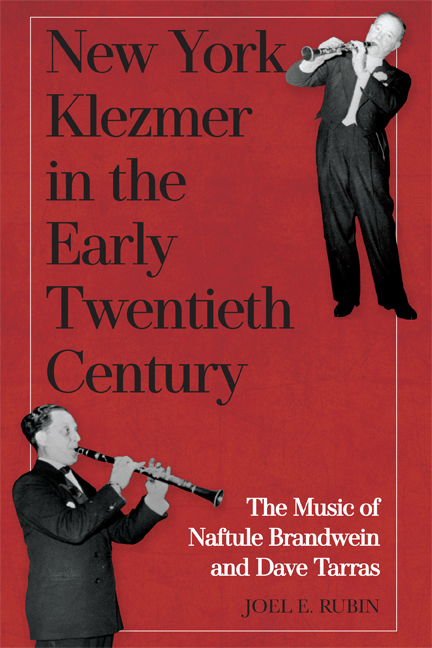Book contents
- Frontmatter
- Contents
- Acknowledgments
- List of Abbreviations
- Note on Orthography and Transliteration
- About the Companion Website
- Introduction: “If You Called Me A Klezmer Thirty-Five Years Ago …”
- 1 A Wedding in Town Was Like a Holiday: A Short History of Klezmorim in Europe
- 2 Klezmer in New York: Changing Meanings, Changing Contexts
- 3 A Kind of “Ethnomusicological Archive”: Commercial 78-rpm Recordings of Klezmer Music
- 4 A Single Field Irrespective of Origin: Polymusicality and Language, Aesthetics, Classification, and Transcription
- 5 “What Mattered Was What’s Happening with the Tune”: Modality and Compositional Processes
- 6 “The Little Things That They Do”: Ornaments and Performance Practice Techniques
- 7 “The Newest Bulgar Out That Everyone Played”: New York Klezmer after 1929
- Glossary
- Notes
- Bibliography
- Index
1 - A Wedding in Town Was Like a Holiday: A Short History of Klezmorim in Europe
Published online by Cambridge University Press: 11 September 2020
- Frontmatter
- Contents
- Acknowledgments
- List of Abbreviations
- Note on Orthography and Transliteration
- About the Companion Website
- Introduction: “If You Called Me A Klezmer Thirty-Five Years Ago …”
- 1 A Wedding in Town Was Like a Holiday: A Short History of Klezmorim in Europe
- 2 Klezmer in New York: Changing Meanings, Changing Contexts
- 3 A Kind of “Ethnomusicological Archive”: Commercial 78-rpm Recordings of Klezmer Music
- 4 A Single Field Irrespective of Origin: Polymusicality and Language, Aesthetics, Classification, and Transcription
- 5 “What Mattered Was What’s Happening with the Tune”: Modality and Compositional Processes
- 6 “The Little Things That They Do”: Ornaments and Performance Practice Techniques
- 7 “The Newest Bulgar Out That Everyone Played”: New York Klezmer after 1929
- Glossary
- Notes
- Bibliography
- Index
Summary
While the klezmer tradition seems to have emerged by the sixteenth century in eastern Europe and its roots stem from the German lands in the twelfth century, my primary focus in this chapter is on the musical culture as it developed in Yiddish-speaking eastern Europe during the nineteenth century and its connection to the klezmer tradition in New York.
It is likely that the early Jewish instrumentalists in Ashkenaz followed the same migratory patterns as the Ashkenazic communities in general. Accordingly, a form of Jewish instrumental music would at some point have been brought from Ashkenaz to Poland-Lithuania with the eastward migrations of the Jews. Perhaps the first evidence of an instrumental specialization among Jewish musicians was the formation in 1558 of a Jewish musicians’ guild in Prague, the Prager Juden-Spielleutezunft.
Life in the Jewish Towns and Cities
The Yiddish-speaking Jews of eastern Europe shared a common culture and lifestyle that differed from those of their Christian neighbors. Their way of dress, dietary laws (kashrut), religious calendar, and language set them apart. The Jews lived primarily in towns and cities where they earned their livings as artisans and petty traders, whereas non-Jews were a mostly agricultural population and tended to live in villages. The poor living conditions and illiteracy of the Christian peasants discouraged acculturation by the Jews to non-Jewish languages and culture. Whereas non-Jews spoke languages such as Polish, Lithuanian, Ukrainian, Belarusian, Russian, and Romanian, the mother tongue of most Jews was Yiddish. As Benjamin Harshav notes, the Jews mostly did not live among speakers of the state language but rather were a minority alongside other minorities that spoke a variety of languages. This “enhanced the preservation of Yiddish—and of Jewish cultural autonomy in general—in the densely populated Jewish small towns or city quarters.” The division between Jews and Christians was reinforced not only by cultural differences but by negative attitudes toward one another as well.
After the partitioning of Poland during the period 1772–95, the majority of Polish Jews became subjects of imperial Russia—where they were confined to the Pale of Settlement—whereas the rest came under Habsburg and Prussian control. The Jews in these three states experienced divergent political conditions throughout the nineteenth century.
- Type
- Chapter
- Information
- New York Klezmer in the Early Twentieth CenturyThe Music of Naftule Brandwein and Dave Tarras, pp. 14 - 33Publisher: Boydell & BrewerPrint publication year: 2020



